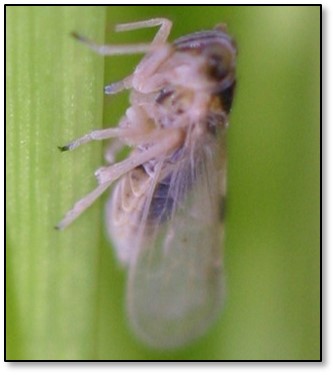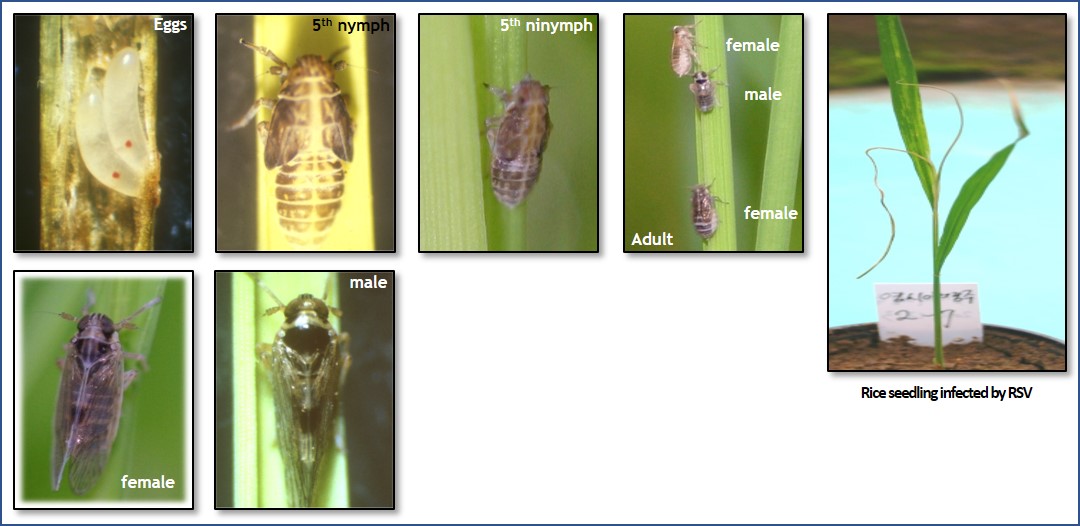
 ¤ýPrincipal Investigator : Boyoon Seo
¤ýPrincipal Investigator : Boyoon Seo¤ýAffiliation : National Institute of Agricultural Sciences, Rural Development Administration ¤ýAddress : 166 Nongsaengmyeong-ro, Wanju-gun, Rep. of Korea (South Korea) ¤ýPhone : +82-63-238-3289 ¤ýE-mail : seoby@korea.kr ¢Â IntroductionThe small brown planthopper (SBPH), Laodelphax striatellus Fallén (Hemiptera: Delphacidae) is a hemimetabolous insect of which body size is less than 5 mm and has diploid bisexual chromosome (2n = 28 + XX or XO). SBPH is widely distributed in Asia, Europe, and Northern Africa and mainly feeds on the grass family, Poaceae. SBPH is one of the major pests against rice plant, Oryza sativa L. in East Asia. High density of SBPH could cause severe economic damage on rice plant by directly sucking and indirectly transmitting viral pathogens, rice stripe virus and rice streaked dwarf virus, with piercing mouthparts (i.e. Stylets). Rice stripe virus can be transmitted in a circulative, persistent, propagative manner by SBPH. SBPH has wing-size dimorphism (short vs. long) depending on genetic and environmental effect. A long-winged SBPH has been reported to massively migrate from China to Korea and Japan in early summer season. Nymphs of SBPH can also overwinter in temperate regions. Furthermore, SBPH has developed high resistance to diverse classes of insecticides including organophosphates, neonicotinoids, chitin biosynthesis inhibitor, etc., in the laboratory and the field. SBPH is taxonomically close to the brown planthopper (BPH), Niaparvata lugens (Stal) (Hemiptera: Delphacidae) which is another destructive rice pest, but diverse host range, different kind of virus transmission, and cold tolerance of SBPH are quite different from those of BPH. All these features could result in SBPH management problem in East Asia, so that genome-wide study through whole-genome sequencing may provide valuable insight to better understand the biological system of SBPH and the interrelationship among rice plant, virus, SBPH, and environmental factors and to develop new target site for pest management. |
|
|||
¢Â ClassificationDelphacidae (Family): Hemiptera (Order): Insecta (Class): Arthropoda (Phylum)¢Â DistributionNortheast Asia, Europe, Northern Africa, Russia, India, Thailand, Vietnam, Indonesia, the Philippines, Micronesia (higher altitudes in tropical Asia -upland rice)(Wilson & Claridge, 1991; Plantwise Knowledge Bank) ¢Â Morphology and Biology¤ý Male 3.4-3.6mm, female 3.6-3.8mm¤ý Shiny black mesonotum of the male ¤ý Sap-sucking mouthparts, transparent wings ¤ý Hemimetabolous (ºÒ¿ÏÀüº¯ÅÂ), 2n=28+(XO: male or XX: female) ¤ý Life cycle: Egg-Nymph(1st-5th instar)-Adult (approx. 25 days, 25¡Æc) ¤ý Overwintering available in South Korea ¤ý Long distance migration from the East China to Korea and Japan ¤ý Virus vector: rice stripe virus (RSV), rice black-streaked dwarf virus (RBSDV) ¢Â Host cropsAvena sativa (oats), Oryza sativa (rice), Triticum aestivum (wheat), Hordeum vulgare (barley), Zea mays (corn) etc. |
||||
